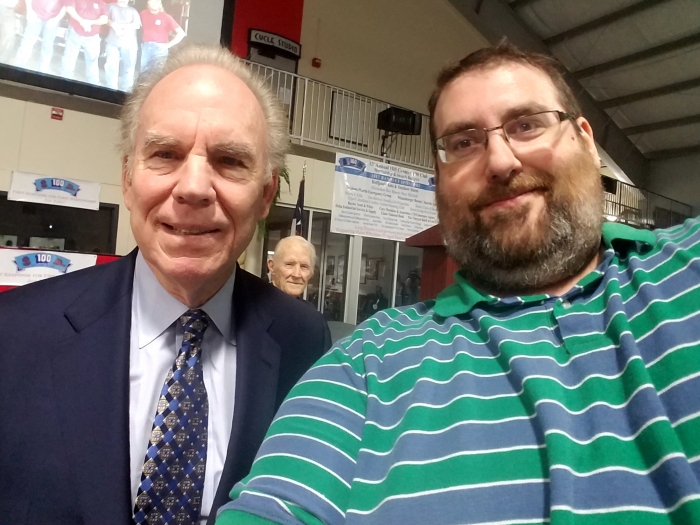Reliving the improbable 'Hail Mary' pass

It only took 47 years plus, but Managing Editor Lew K. Cohn finally got to meet Roger Staubach at the 15th Annual Hill Country 100 Club Awards Banquet in Burnet on Jan. 18 and hear the story of the 'Hail Mary' pass from the legend himself.
Lew K. Cohn
Managing Editor
The Highlander
The year was 1975 and I was in kindergarten. My favorite NFL football team was the Dallas Cowboys and my favorite player, without a doubt, was the quarterback, No. 12, future Hall of Famer Roger Staubach. My family were staunch Cowboys supporters and had been since the team was first formed as an expansion team in 1960. Blankets, pillowcases, toboggan hats, even pajamas — if it was branded with the “star,” I most likely got it from my parents in the 1970s.
An event would happen that year that would have a lasting impact on my friends and me as Cowboy fans. Of course, I am talking about the famous “Hail Mary” pass from Staubach to Drew Pearson to win the NFC Divsional playoffs.
Just a few days after Christmas that year, the Cowboys, the wild-card team, were taking on the powerful Minnesota Vikings in the first-round of the NFL playoffs. The Vikings, 12-2 that season, were led by their own future Hall of Famer in Fran Tarkenton, the MVP that season after throwing for 2,994 yards and 25 touchdowns while completing a league-leading 64.2 percent of his passes.
Chuck Foreman was their elusive All-Pro running back with the nickname “The Spin Doctor” because of how he would avoid tackles and make his opponents sick. He had led the league with 73 receptions that year, finished second in the NFC in rushing with 1,070 yards and scored 22 TDs that season.
The Vikings' offense was the fifth best in the NFL that year — a well-oiled machine. But it was their defense, led by their front four known as the “Purple People Eaters,” that was truly scary. The league-leading defense recorded 46 sacks and allowed the fewest yards both rushing and passing. Defensive back Paul Krause even set a single-season team record with 10 interceptions.
No one had expected the Dallas Cowboys to be able to compete on the same field with Minnesota. That season, the Cowboys defied logic by finishing 10-4, good for second in the NFC East behind St. Louis (11-3). At that time, the NFL only had one wild-card team make the playoffs and the Cowboys
In the offseason, the Cowboys had 12 rookies make the team — they were known colloquially as “The Dirty Dozen.” With so many young players in the fold, and great concerns about keeping Staubach healthy and upright for the season (he had been sacked nearly 90 times in the previous two years), Head Coach Tom Landry unveiled a “new” formation designed to give Staubach an extra second or two to make plays — the shotgun, or “spread.” Staubach responded by making the All-Pro team, passing for 2,666 yards and 17 touchdowns while also rushing for 316 yards.
Because they were the top team in the league, Minnesota hosted the Dec. 28, 1975, game at chilly (25 degrees at kickoff) Metropolitan Stadium, aka “The Met,” with announcers Gary Bender and Johnny Unitas calling the contest. I remember watching the Sunday afternoon game with my parents while we were living in my hometown of Greenville, Mississippi.
After a scoreless first quarter, the Vikings drew first blood. Foreman scored on a one-yard run and the PAT made it 7-0 Minnesota, which it would remain for the rest of the first half. In the third quarter, Dallas got the equalizer when Doug Dennison rushed for a four-yard TD and the PAT tied the game at 7-7.
On the first play of the fourth quarter, kicker Toni Fritsch's 24-yard field goal would give the visiting Cowboys a 10-7 lead, their first of the game, but when the Vikings scored on a one-yard Brent McClanahan TD run to go up 14-10 with 5:11 left in the game, things looked bleak for Dallas.
They looked even worse when the Cowboys could do nothing with the ball and Minnesota drove to the Cowboys 47 with 2:20 left in the game and a crucial third and 2. If the Vikings got a first down, the game was essentially over.
Minnesota opted to pass instead of run the ball and Dallas safety Charlie Waters got into the backfield and sacked Tarkenton for a loss, forcing the Vikings to punt after the two-minute warning. Dallas would get the ball back at their own 15 with 1:51 left, setting up one of the most-famous drives in NFL history.
On first down, Staubach completed a pass to Drew Pearson for nine yards as Pearson went out of bounds. It was his first catch of the game, but it wouldn't be his last. On second down, Staubach's pass to Golden Richards was broken up, bringing up third and 1. Staubach rolled out of trouble and hit Pearson for a seven-yard gain to give the Cowboys a first down at their own 31.
Disaster nearly struck the next play as center John Fitzgerald's snap scooted across the turf, forcing Staubach to fall on the ball to secure it at the 25 for a loss of six. On second down, Staubach was hit as he tried to throw a pass down the left sideline and the ball sailed out of bounds. On third down, Staubach overthrew the tight end, bringing up fourth down and 17 with just 44 seconds left and the Cowboys' season was down to a final play.
The Cowboys pulled Fitzgerald and replaced him with rookie Kyle Davis at center. That move may have helped save the season as Staubach cleanly caught the shotgun snap, dropped back and fired towards the right sideline for Pearson, who caught the ball in midair before being knocked out of bounds by defensive back Nate Wright at midfield.
NFL rules at the time credited a catch if a receiver caught the ball and was force out of bounds in air, so Pearson's acrobatic 25-yard grab gave the Cowboys a first and 10 with 37 seconds left. Staubach had Preston Pearson wide open on the next play, but the veteran inexplicably dropped the ball and the Cowboys had 32 seconds left to leave their mark on history.
On second down, Staubach took the snap, made a pump fake to the left and then unleashed the ball down the right sideline to Drew Pearson, who was running step for step with Wright. The ball was underthrown a hair and Pearson cut his route short and reached back to haul in the ball as Wright fell down. Pearson scooted untouched into the end zone before Krause could tackle him for a 50-yard TD reception. He jubilantly threw the ball over the scoreboard and the Cowboys converted the PAT for a 17-14 lead.
Tarkenton and the Vikings would have one last chance, but Ed “Too Tall” Jones sacked Tarkenton on first down at the Vikings 1, nearly ending the game with a safety as Tarkenton barely stayed out of the end zone. Tarkenton got up and starting screaming at the referee and that's when one Vikings fan decided to take matters into his own hands, throwing a liquor bottle at and hitting field judge Armen Terzian in the head, temporarily knocking out the official.
After order was restored, the Cowboys allowed the Vikings to get a short gain by Foreman and then sacked Tarkenton on the last play of the game to seal the victory.
In the triumphant Dallas lockerroom, an Associated Press reporter asked Staubach about the TD pass to Pearson and he said, “I closed my eyes and said a 'Hail Mary.'” While the phrase had been used a few times before by prominently Catholic colleges to describe wildly improbable, last-gasp pass attempts, Staubach's words would find themselves in the national lexicon as the “Hail Mary pass.”
From that moment forward, when my friends and I were outside playing football, we were reliving that game. We were Staubach, faking the throw to Golden Richards and then letting the ball fly with all our might down the sidelines. We were Drew Pearson, reaching back and making a spectacular hip catch before shuffling into the end zone to win the game. That game, in my mind, helped solidify Dallas as the personification of “never say quit” and helped Tex Schramm brand the Cowboys “America's Team.”
About 12 years ago, I got to meet Drew Pearson with my kids at an event in Texarkana, and just last Thursday, I finally got to meet Staubach at the Hill Country 100 Club banquet in Burnet. In both instances, I got the opportunity to speak to my idols about one of the greatest games ever played, and, for at least one moment more, relive a moment that has been special to me for more than 42 years — a moment that inspires me to never say quit and to never give up, but to keep on playing until the last tick of the clock.






